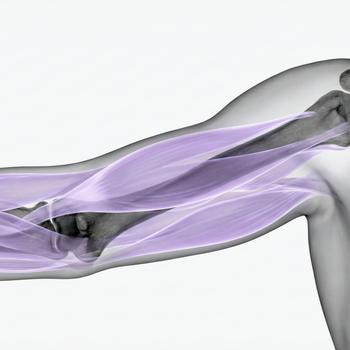Quick version
The upper arm is an important structure for arm strength, movement and function, and can suffer from both acute and overuse-related problems.
- Consists of the humerus bone and the biceps and triceps muscles
- Controls the flexion and extension of the arm
- Common problems include muscle and nerve damage
- Important for lifting, pulling and pressing in everyday life
- Investigated with clinical examination and imaging
What is the upper arm?
The upper arm is the part of the arm that extends from the shoulder joint to the elbow joint. It consists of a long bone – the humerus – which is surrounded by powerful muscles such as the biceps and triceps. The upper arm acts as an important lever for all movements of the arm and is central to all forms of lifting, pulling and pushing.
Anatomy of the upper arm
The bone in the upper arm is called the humerus and extends from shoulder to elbow. Several muscles surround the bone, including the biceps brachii (front) and triceps brachii (back). Important nerves such as the radial, median, and ulnar nerves pass through the upper arm and can be affected if injured.
Muscles of the upper arm
The biceps is responsible for elbow flexion and supination (turning the palm of the hand upward), while the triceps is responsible for elbow extension. These muscles are active in many everyday and sports-related movements.
Function and biomechanics
The upper arm allows for flexion, extension, and rotation of the forearm. It also acts as a force transmitter from the shoulder to the hand, and its muscles play a crucial role in arm strength and control.
Common conditions and diseases
Pain in the upper arm can be due to muscle strains, tendonitis, nerve compression, or fractures. Overuse injuries from repetitive work or sports are common, especially with unilateral movements.
Examination and diagnosis
When investigating upper arm problems, a clinical examination of mobility, muscle strength and nerve function is performed. Imaging tests such as X-ray, ultrasound or MRI of the upper arm are used when a fracture or soft tissue injury is suspected.
Relevant symptoms
- Pain in the front or back of the upper arm
- Weakness when lifting or pressing
- Tingling or numbness in the arm
- Bruises or swelling after injury
- Limited mobility in the shoulder or elbow
Related conditions and diagnoses
- Biceps rupture
- Triceps rupture
- Umbral fracture
- Muscle rupture
- Radial nerve damage






















